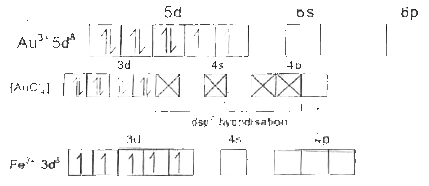How do you account for the indicated molecular geometry for the following compounds in terms of valence bond theory. [Auc––––––(4)]− - square-planar, [Fe(CN)6]3− - octahedral, [GaCl4]− tetrahedral, [Nicia) tetrahedral
Topper's Solved these Questions
- TRANSITION ELEMENTS & COORDINATION COMPOUNDSBOOK - FIITJEECHAPTER - TRANSITION ELEMENTS & COORDINATION COMPOUNDSEXERCISE - SOLVED PROBLEMS (OBJECTIVE)
48 Videos
- TRANSITION ELEMENTS & COORDINATION COMPOUNDSBOOK - FIITJEECHAPTER - TRANSITION ELEMENTS & COORDINATION COMPOUNDSEXERCISE - COMPREHENSION
6 Videos
- TRANSITION ELEMENTS & COORDINATION COMPOUNDSBOOK - FIITJEECHAPTER - TRANSITION ELEMENTS & COORDINATION COMPOUNDSEXERCISE - MATCHIG LIST TYPE QUESTIONS
1 Videos
- THERMODYNAMICS AND THERMOCHEMISTRY BOOK - FIITJEECHAPTER - THERMODYNAMICS AND THERMOCHEMISTRY EXERCISE - SINGLE INTEGER ANSWER TYPE QUESTIONS
5 Videos
Similar Questions
How do you account for the indicated molecular geometry for the following compounds in terms of valence bond theory. [AuCl4]− - square-planar, [Fe(CN)6]3− - octahedral, [GaCl4]− tetrahedral, [NiCl4] tetrahedral
View SolutionHow will you account for the indicated molecular geometry of the following compounds in terms of valence bond theory ?
[ArCl4]− is square planar while [GaCl4]− is tetrahedral .
View SolutionDiscuss the geometry of the complex [Fe(CN)6]3− on the basis of valence bond theory.
View SolutionDiscuss the nature of bonding in the following coordination entities on the basis of Valence Bond Theory :
Fe(CN)6]4−
View SolutionExplain on the basis of valence bond theory that [Ni(CN)4]2− ion with square planar structure is diamagnetic and the [NiCl4]2− ion with tetrahedral geometry is paramagnetic.
View SolutionExplain on the basis of valence bond theory that [Ni(CN)4]2− ion iwth square planar structure is diamagnetic and [NiCl4]2− ion iwth tetrahedral geometry is paramagnetic.
View SolutionDiscuss the nature of bonding in the following co-ordination complexes on the basis of valence bond theory :
(a) [Fe(CN)6]4− (b) [FeF6]3−
(c) [Co(C2O4)3]3− (d) [CoF6]3−
View SolutionDiscuss the nature of bonding in the following coordination entities on the basis of valence bond theory:
(i). [Fe(CN)6]4−
(ii). [FeF6]3−
(iii). [Co(C2O4)3]3−
(iv). [CoF6]3−
View SolutionDiscuss the nature of bonding in the following coordination entities on the basis of valence bond theory:
(i). [Fe(CN)6]4−
(ii). [FeF6]3−
(iii). [Co(C2O4)3]3−
(iv). [CoF6]3−
View SolutionDiscuss the nature of bonding in the following coordination entities on the basis of valence bond theory:
(i). [Fe(CN)6]4−
(ii). [FeF6]3−
(iii). [Co(C2O4)3]3−
(iv). [CoF6]3−
View Solution


